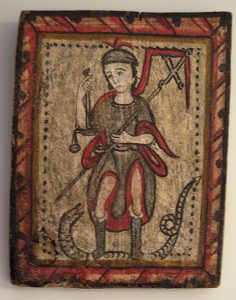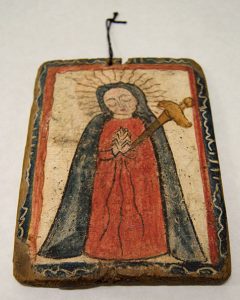RETABLOS AND BULTOS FROM THE NORTHERN RIO GRANDE REGION
Retablos are small oil paintings on tin, wood or copper which were used in home altars to venerate the almost infinite number of Catholic saints. The literal translation for ‘retablo’ is ‘behind the altar.’
This genre of folk art, deeply rooted in Spanish history, represents the heart and soul of traditional religious beliefs in 17th, 18th, and 19th century Mexican culture. Symbolic, allegorical, historical, folkloric and spiritual are just a few of the words that best describe this unique art form.
The retablo was an art form that flourished in post conquest Mexico and then ultimately, with the introduction of inexpensive mediums such as tin, reached its pinnacle of popularity in the last quarter of the 19th century.
These oil paintings were sold to devout believers who displayed them in home altars to honor their patron saints. There are virtually hundreds of saints, each invoked to remedy a different situation. “San Ysidro Labrador,” the patron saint of farmers, is venerated for good weather, agricultural issues and prosperous crop. He is often called upon before picnics or just before harvest. Having spent four years in the forest as a hermit, San Jeronimo, the patron saint of scholars and philosophers, is invoked for protection against temptations and want.
This unique art form is a hybrid of centuries old Catholic iconography and indigenous artistry; reflecting the historical, cultural and religious links between “old” and “new” worlds (Mexican Retablos, 2016).
San Isidro, Labrador (Saint Isidore, the Farmer)
 J. Rafael Aragón (c. 1820-1865). San Isidro Labradór (Saint Isidore, the Farmer). Pine, gesso, paint. Gift of Charles H. Woodard and Beryl G. Woodard. 1965.1.50
J. Rafael Aragón (c. 1820-1865). San Isidro Labradór (Saint Isidore, the Farmer). Pine, gesso, paint. Gift of Charles H. Woodard and Beryl G. Woodard. 1965.1.50
Isidro (Isidore) was born in Madrid, Spain in the latter half of the 12 century. For the greater part of his life he was employed as a laborer for a wealthy estate owner on a farm. Many marvelous happenings accompanied his lifelong work in the fields and continued long after his death. It is said the angels sometimes helped him in his work in the fields. He is usually depicted with an angel driving a plow pulled by yoked oxen, as he follows praying. The angel was sent by God to allow Isidore to continue praying for an end to the drought. St. Isidore was canonized in 1622. He is the patron saint of farmers and laborers. Feast day is May 15th.
Santero Jose Rafael Aragon was from Cordova, New Mexico. He was not related to santero Jose Aragon. His earliest recorded large altar screen is a mission of San Lorenzo at Picuris Pueblo. Jose’s style of work are heavy outlines, clear color areas, and attractive images. His production of figures in the round are also great works of art. They are distinguished by an elongation of body proportions, pleasing features, and bright pure coloring. It is believed that Jose Rafael had helpers in order to accomplish so much work. This might explain the sometimes uneven quality of his larger pieces (Boyd, 1962).
San Miguel Arcángel (Saint Michael, the Archangel)

Anonymous, c. 19th century. San Miguel Arcángel (Saint Michael, the Archangel). Pine, paint, gesso. Gift of Charles H. Woodard and Beryl G. Woodard. 1965.1.52
 J. Rafael Aragón, c. 1820-1865. San Miguel Arcángel (Saint Michael, the Archangel). Pine, gesso, paint. Gift of Charles H. Woodard and Beryl G. Woodard. 1965.1.51
J. Rafael Aragón, c. 1820-1865. San Miguel Arcángel (Saint Michael, the Archangel). Pine, gesso, paint. Gift of Charles H. Woodard and Beryl G. Woodard. 1965.1.51
Saint Michael is one of the three Archangels, he is a princely seraph, an angel of supreme power and the leader of God’s army. He is a guardian connected with the battle against Satan and his followers. St. Michael who, at God’s commands will reprise his role against the Antichrist in the End Times.
Feast day is September 29. Michael signifies “Who is like God.” He is the special patron of soldiers, policemen, grocers, doctors, paratroopers, mariners, and sickness.
Nuestra Señora de los Dolores (Our Lady of Sorrows)

Pedro Antonio Fresquís (c. 1749-1831). Nuestra Señora de los Dolores (Our Lady of Sorrows). Pine, gesso, paint. Gift of Charles H. Woodard and Beryl G. Woodard. 1965.1.53
Nuestra Señora de los Dolores (Our Lady of Sorrows) is one of the many titles for Mary, the mother of Jesus. Mary is shown enduring the sorrows predicted in Luke 2:35, especially that of the crucifixion of her son. This particular retablo of Nuestra Señora de los Dolores shows one sword piercing Mary’s heart; however, some images show seven swords piercing her heart. Nuestra Señora de los Dolores is a definite interest to the Penitentes, since it is usually the Dolores who engages in the Encuentro as Christ moves toward Calvary (Steele, 1982).
Santero Pedro Antonio Fresquis was born in 1749 and grew up in Las Truchas (New Mexico). His descendants can be traced back to 1625 when they came to New Mexico. Over his lifetime of 82 years he created many altar screens, bultos, and retablos. Fresquis sense of space filling by improvised motifs and habit of incising through the painted surface into the gesso identifies his work. Although his works were not signed he drew a Spanish brand-mark for his initials “PF” and placed it on beasts which were part of artwork or on the reverse of his work. This was an extension of an old Spanish prejudice against an artist’s signing their name on a religious image. Fresquis died in 1831 and is buried at the church yard of the Santuario at the Potero of Chimayo (Boyd, 1962).
Bultos are wooden sculptures of saints and other religious figures. They are also called “santos,” which refers to the depiction of saints. The Spanish word santo means holy. The noun means holy person or object (such as the cross on which Christ was crucified) or an image of someone or something holy. Imagen de bulto is a figure carved or molded in the round. At times the bulto is roughly finished except for the head and hands because it was intended to be dressed in fabric. The Spanish word Santero means a custodian of holy images or the maker of santos (Boyd, 1962).
San Roque (Saint Roch) or San Antonio de Padua (Saint Anthony of Padua)

Anonymous, 19th century. San Roque (Saint Roch) or San Antonio de Padua (Saint Anthony of Padua). Pine, gesso, paint. Gift of Charles H. Woodard and Beryl G. Woodard.1965.1.35
This is a bulto of San Antonio appears to have been changed into a bulto of San Roque or vice versa. As the needs of the owner change sometimes bultos are altered to represent other divine figures. The torn robe and the wound on the leg are elements of San Roque. Holding the baby Jesus is a feature of San Antonio.
BIBLIOGRAPHY
Boyd, E. The New Mexico Santero. Museum of New Mexico, 1969.
Mexican Retablos: 19th Century Devotional Art. Colonial Arts. web. Nov. 16, 2016.
Steele, Thomas J. Santos and Saints: The Religious Folk Art of Hispanic New Mexico. Ancient City Press. Santa Fe, New Mexico. 1982.
